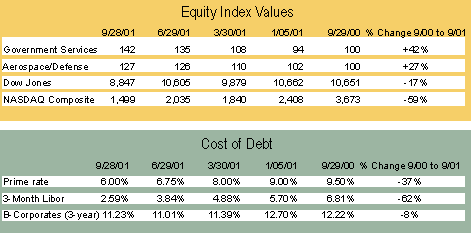MARKET WATCH
Most of the time, investor excitement and public-sector-oriented companies are mutually exclusive. But not now. The emergence of a strong appetite and intense interest in companies serving government and defense markets has been dramatic.
Most of the time, investor excitement and public-sector-oriented companies are mutually exclusive. But not now. The emergence of a strong appetite and intense interest in companies serving government and defense markets has been dramatic.Investors, who between 1998 and 2000 showed disdain for the ho-hum, slow and steady federal markets, have undergone a transformation in thinking. Technology-based companies serving commercial markets have turned a positive eye toward government tech services companies and federal integrators.In addition, investment bankers and consultants with no understanding of this market space ? who may have thought that C4ISR was a European import ? are racing into the industry in large numbers.From an industry perspective, it feels great to be loved ? particularly after being ignored. Some of this love affair may endure as our nation's priorities are reset. Industry merger and acquisition activity and market pricing will be affected. Most of the impact will be on the positive side. First, some historical context. Before Sept. 11, this year was shaping up as a challenging one for most segments of the capital markets. The tech meltdown, a slowing economy and a prevailing cautionary psychology among capital sources and investors were pushing most stock indices downward. Banks and other cash flow lenders were tightening standards and requiring that buyers bring more equity to the table when attempting to acquire other companies. This pushed down the cash price that buyers could afford to pay and altered the capital structure of many merger and acquisition transactions. Most projections of economic recovery were pointing toward mid to late 2002.More recently, the terrorist attacks produced an enormous, additional layer of uncertainty for companies and investors alike. Many decisions, both personal and business related, have been deferred pending greater clarity about the effects of this new environment. The primacy of domestic security, relative to our psychological well-being as well as our economic health, could not have been more dramatically highlighted. Accordingly, the role of the public sector in restoring confidence and normalcy has been widely accepted by the taxpayer. The bottom-line conclusion is that government must have the resources necessary to successfully contain terrorism and restore domestic tranquillity.Flowing from these events and perspectives is the consensus that defense and intelligence activities will receive substantial increases in federal spending. Further, there is a good case for re-establishing the belief that national defense and domestic security are, indeed, government's most important responsibility. This perspective will be sustained beyond the near term, giving support to more optimistic expectations that budget priority for government activities connected to physical security, information security, defense technology and related activities will be sustained.Evidence of these perspectives is reflected in the market pricing trends of government tech services (GTS) and aerospace and defense companies in public market trading. Examining the past 12-month period (September 2000 through September 2001) reveals the stark contrast between public-sector companies and broad market indices. While the Dow Jones Industrials declined by 17 percent and the NASDAQ composite fell by almost 60 percent, the government services and aerospace and defense indices were up by 42 percent and 27 percent, respectively. During this same period, the cost of debt capital declined dramatically as the Federal Reserve sought to re-invigorate the economy through monetary easing and discount rate reductions. Interest rates determined by market factors rather than regulators, specifically the London Inter-Bank Offered Rate, reflect a huge decline of 62 percent during this period. The effect of rising equity values (market value) and falling cost of debt is a significant reduction in the weighted average cost of capital or WACC.The capital structure of public government services companies, reflecting approximately 10 percent debt-to-enterprise-value ratios, infers a 25 percent-plus reduction in WACC, providing increased acquisition capacity. For the aerospace and defense group, with a 30 percent debt to enterprise value ratio, the reduction in WACC is about 15 percent.In the merger and acquisition environment, an offsetting factor driving the WACC upward is the reduction in the debt-to-EBITDA ratio, which is used by banks and other debt capital sources to establish the level of transaction funding to be provided based upon cash flow. A reduction of 30 percent to 40 percent in these ratios has the effect of increasing the WACC in cash acquisitions. This means that acquiring companies, which in the government market have seen their stock values rise, can offer higher prices for their acquisitions when they pay with stock than with cash.On balance, both the pace of industry mergers and acquisitions and the sale value levels should remain strong well into 2002.And, by the way, C4ISR stands for Command, Control, Communications, Computers, Intelligence, Surveillance and Reconnaissance.


Jerry Grossman is managing director at Houlihan Lokey Howard & Zukin in McLean, Va.

Jerry Grossman

Jerry Grossman is managing director at Houlihan Lokey Howard & Zukin in McLean, Va.
NEXT STORY: SeeBeyond Peers into Government Market

